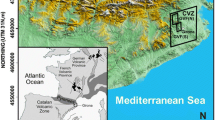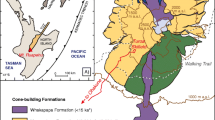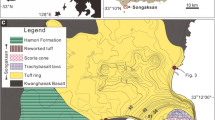Abstract
Erosion has revealed a remarkable section through the heart of a volcanic island, Mason Spur, in the southwestern Ross Sea, Antarctica, including an unusually well-exposed section of caldera fill. The near-continuous exposure, 10 km laterally and > 1 km vertically, cuts through Cenozoic alkalic volcanic rocks of the Erebus volcanic province (McMurdo Volcanic Group) and permits the study of an ancient volcanic succession that is rarely available due to subsequent burial or erosion. The caldera filling sequence includes an unusual trachytic spatter-rich lapilli tuff (ignimbrite) facies that is particularly striking because of the presence of abundant black fluidal, dense juvenile spatter clasts of trachytic obsidian up to 2 m long supported in a pale cream-coloured pumiceous lapilli tuff matrix. Field mapping indicates that the deposit is an ignimbrite and, together with petrological considerations, it is suggested that mixing of dense spatter and pumiceous lapilli tuff in the investigated deposit occurred during emplacement, not necessarily in the same vent, with the mixed fragmental material emplaced as a pyroclastic density current. Liquid water was not initially present but a steam phase was probably generated during transport and may represent water ingested during passage of the current as it passed over either wet ground, stream, shallow lake or (possibly) snow. Well-exposed caldera interiors are uncommon and that at Mason Spur is helping understand eruption dynamics associated with a complex large island volcano. The results of our study should help to elucidate interpretations of other, less well exposed, pyroclastic density current deposits elsewhere in Antarctica and globally.








Similar content being viewed by others
References
Allen SR (2005) Complex spatter- and pumice-rich pyroclastic deposits from an andesitic caldera-forming eruption: the Siwi pyroclastic sequence, Tanna, Vanuatu. Bull Volcanol 67:27–41
Bear AN, Cas RAF, Giordano G (2009a) The implications of spatter, pumice and lithic clast rich proximal co-ignimbrite lag breccias on the dynamics of caldera forming eruptions: the 151 ka Sutri eruption, Vico volcano, Central Italy. J Volcanol Geotherm Res 181(1-2):1–24. https://doi.org/10.1016/j.jvolgeores.2008.11.032
Bear AN, Cas RAF, Giordano G (2009b) Variations in eruptive style and depositional processes associated with explosive, phonolitic composition, caldera-forming eruptions: the 151 ka Sutri eruption, Vico caldera, central Italy. J Volcanol Geotherm Res 184(3):225–255. https://doi.org/10.1016/j.jvolgeores.2009.04.005
Branney M, Kokelaar P (1992) A reappraisal of ignimbrite emplacement: progressive aggradation and changes from particulate to non-particulate flow during emplacement of high-grade ignimbrite. Bull Volcanol 54(6):504–520. https://doi.org/10.1007/BF00301396
Branney MJ, Kokelaar P (2002) Pyroclastic density currents and sedimentation of ignimbrites. Geo Soc Mem 27:1–138
Brown RJ, Bonadonna C, Durant AJ (2012) A review of volcanic ash aggregation. Phys Chem Earth 45-46:65–78. https://doi.org/10.1016/j.pce.2011.11.001
Cashman KV, Mangan MT, Newman S (1994) Surface degassing and modifications to vesicle size distributions in active basalt flows. J Volcanol Geotherm Res 61(1-2):45–68. https://doi.org/10.1016/0377-0273(94)00015-8
Dávila-Harris P, Ellis BS, Branney MJ, Carrasco-Núñez G (2013) Lithostratigraphic analysis and geochemistry of a vitric spatter-bearing ignimbrite: the Quaternary Adeje Formation, Cañadas volcano, Tenerife. Bull Volcanol 75(6):1–15
Di Genova D, Romano C, Hess KU, Vona A, Poe BT, Giordano D, Dingwell DB, Behrens H (2013) The rheology of peralkaline rhyolites from Pantelleria Island. J Volcanol Geotherm Res 249:201–216. https://doi.org/10.1016/j.jvolgeores.2012.10.017
Druitt TH, Sparks RSJ (1982) A proximal ignimbrite breccia facies on Santorini. Greece J Volcanol Geotherm Res 13(1):147–171. https://doi.org/10.1016/0377-0273(82)90025-7
Druitt TH, Sparks RSJ (1984) On the formation of calderas during ignimbrite eruptions. Nature 310(5979):679–681. https://doi.org/10.1038/310679a0
Elliot DH, Hanson RE (2001) Origin of widespread, exceptionally thick basaltic phreatomagmatic tuff breccia in the Middle Jurassic Prebble and Mawson Formations, Antarctica. J Volcanol Geotherm Res 111(1-4):183–201. https://doi.org/10.1016/S0377-0273(01)00226-8
Furukawa K, Kamata H (2004) Eruption and emplacement of the Yamakogawa rhyolite in central Kyushu, Japan: a model for emplacement of rhyolitic spatter. Earth Planets Space 56(5):517–524. https://doi.org/10.1186/BF03352511
Giannetti B, Luongo G (1994) Trachyandesite scoria-flow and associated trachyte pyroclastic flow and surge at Roccamonfina volcano (Roman Region, Italy). J Volcanol Geotherm Res 59(4):313–334. https://doi.org/10.1016/0377-0273(94)90085-X
Giordano D, Romano C, Papale P, Dingwell DB (2004) The viscosity of trachytes, and comparison with basalts, phonolites, and rhyolites. Chem Geol 213(1):49–61. https://doi.org/10.1016/j.chemgeo.2004.08.032
Giordano D, Russell JK, Dingwell DB (2008) Viscosity of magmatic liquids: a model. Earth Planet Sci Lett 271(1):123–134. https://doi.org/10.1016/j.epsl.2008.03.038
Head JW, Wilson L (1989) Basaltic pyroclastic eruptions: influence of gas-release patterns and volume fluxes on fountain structure, and the formation of cinder cones, spatter cones, rootless flows, lava ponds and lava flows. J Volcanol Geotherm Res 37(3-4):261–271. https://doi.org/10.1016/0377-0273(89)90083-8
Houghton BF, Wilson CJN (1989) A vesicularity index for pyroclastic deposits. Bull Volcanol 51(6):451–462. https://doi.org/10.1007/BF01078811
Hughes EC, Neave DA, Dobson KJ, Withers PJ, Edmonds M (2017) How to fragment peralkaline rhyolites: observations on pumice using combined multi-scale 2D and 3D imaging. J Volcanol Geotherm Res 336:179–191. https://doi.org/10.1016/j.jvolgeores.2017.02.020
Kokelaar P, Raine P, Branney MJ (2007) Incursion of a large-volume, spatter-bearing pyroclastic density current into a caldera lake: Pavey Ark ignimbrite, Scafell caldera, England. Bull Volcanol 70(1):23–54. https://doi.org/10.1007/s00445-007-0118-5
Kyle PR (1990) McMurdo Volcanic Group—western Ross embayment: introduction. In: LeMasurier WE, Thompson J (eds) Volcanoes of the Antarctic plate and southern oceans. Antarctic research series 48, pp 18–25. https://doi.org/10.1029/AR048p0018
Le Bas M, Maitre MJ, Streckeisen A, Zanettin B (1986) A chemical classification of volcanic rocks based on the total alkali-silica diagram. J Petrol 27(3):745–750. https://doi.org/10.1093/petrology/27.3.745
Le Losq C, Neuville DR, Moretti R, Kyle PR, Oppenheimer C (2015) Rheology of phonolitic magmas—the case of the Erebus lava lake. Earth Planet Sci Lett 411:53–61. https://doi.org/10.1016/j.epsl.2014.11.042
LeMasurier WE (1990) Late Cenozoic volcanism on the Antarctic Plate: an overview. In: LeMasurier WE, Thomson JW (eds) Volcanoes of the Antarctic plate and southern oceans. American Geophysical Union, Washington, pp 1–17. https://doi.org/10.1029/AR048p0001
Martí J, Geyer A, Aguirre-Diaz G (2013) Origin and evolution of the Deception Island caldera (South Shetland Islands, Antarctica). Bull Volcanol 75(6):732. https://doi.org/10.1007/s00445-013-0732-3
Martin AP (2009) Mount Morning, Antarctica: geochemistry, geochronology, petrology, volcanology, and oxygen fugacity of the rifted Antarctic lithosphere. PhD thesis, Department of Geology, University of Otago, Dunedin, 264 p
Martin AP, Cooper AF (2010) Post 3.9 Ma fault activity within the West Antarctic rift system: onshore evidence from Gandalf Ridge, Mount Morning eruptive centre, southern Victoria Land, Antarctica. Antarct Sci 22(05):513–521. https://doi.org/10.1017/S095410201000026X
Martin AP, Cooper AF, Dunlap WJ (2010) Geochronology of Mount Morning, Antarctica: two-phase evolution of a long-lived trachyte-basanite-phonolite eruptive center. Bull. Volcanol 72:357–371. https://doi.org/10.1007/s00445–00009–00319-00441
Martin AP, Cooper AF, Price RC (2013) Petrogenesis of Cenozoic, alkalic volcanic lineages at Mount Morning, West Antarctica and their entrained lithospheric mantle xenoliths: lithospheric versus asthenospheric mantle sources. Geochim Cosmochim Acta 122:127–152. https://doi.org/10.1016/j.gca.2013.08.025
Martin AP, Price RC, Cooper AF, McCammon CA (2015) Petrogenesis of the rifted southern Victoria land lithospheric mantle, Antarctica, inferred from petrography, geochemistry, thermobarometry and oxybarometry of peridotite and pyroxenite xenoliths from the Mount Morning eruptive centre. J Petrol 56(1):193–226. https://doi.org/10.1093/petrology/egu075
Mattox TN, Mangan MT (1997) Littoral hydrovolcanic explosions: a case study of lava-seawater interaction at Kilauea volcano. J Volcanol Geotherm Res 75(1-2):1–17. https://doi.org/10.1016/S0377-0273(96)00048-0
Mellors RA, Sparks RSJ (1991) Spatter-rich pyroclastic flow deposits on Santorini. Greece Bull Volcanol 53(5):327–342. https://doi.org/10.1007/BF00280225
Palladino DM, Simei S (2005) Eruptive dynamics and caldera collapse during the Onano eruption, Vulsini, Italy. Bull Volcanol 67(5):423–440. https://doi.org/10.1007/s00445-004-0385-3
Panter K, McIntosh W, Smellie J (1994) Volcanic history of Mount Sidley, a major alkaline volcano in Marie Byrd Land, Antarctica. Bull Volcanol 56(5):361–376. https://doi.org/10.1007/BF00326462
Papale P (1999) Strain-induced magma fragmentation in explosive eruptions. Nature 397(6718):425–428. https://doi.org/10.1038/17109
Perrotta D, Scarpati C (1994) The dynamics of the Breccia Museo eruption (Campi Flegrei Italy) and the significance of spatter clasts associated with breccias. J Volcanol Geotherm Res 59(4):335–355. https://doi.org/10.1016/0377-0273(94)90086-8
Rader E, Geist D (2015) Eruption conditions of spatter deposits. J Volcanol Geotherm Res 304:287–293. https://doi.org/10.1016/j.jvolgeores.2015.09.011
Reed SJB (2005) Electron microprobe analysis and scanning electron microscopy in geology. Cambridge University Press, Cambridge, p 189. https://doi.org/10.1017/CBO9780511610561
Roobol MJ, Smith AL, Wright JV (1987) Lithic breccias in pyroclastic flow deposits on St. Kitts, West Indies. Bull Volcanol 49:696–707
Rosi M, Vezzoli L, Aleotti P, De Censi M (1996) Interaction between caldera collapse and eruptive dynamics during the Campanian Ignimbrite eruption, Phlegraean Fields, Italy. Bull Volcanol 57(7):541–554. https://doi.org/10.1007/BF00304438
Rousseau RM (2001) Detection limit and estimate of uncertainty of analytical XRF results. Rigaku J 18:33–47
Sable JE, Houghton BF, Del Carlo P, Coltelli M (2006) Changing conditions of magma ascent and fragmentation during the Etna 122 BC basaltic Plinian eruption: evidence from clast microtextures. J Volcanol Geotherm Res 158(3–4):333–354. https://doi.org/10.1016/j.jvolgeores.2006.07.006
Scarpati C, Cole PD, Perrotta D (1993) The Neapolitan Yellow Tuff—a large volume multiphase eruption from Campi Flegrei, southern Italy. Bull Volcanol 55(5):343–356. https://doi.org/10.1007/BF00301145
Shea T, Gurioli L, Houghton B (2012) Transitions between fall phases and pyroclastic density currents during the AD 79 eruption at Vesuvius: building a transient conduit model from the textural and volatile record. Bull Volcanol 74(10):2363–2381. https://doi.org/10.1007/s00445-012-0668-z
Smellie J, López-Martínez J (2002) Text and geological and geomorphological maps. BAS GEOMAP series, sheets 6-A and 6-B, scale 1: 25 000. Geology and geomorphology of Deception Island. British Antarctic Survey, Cambridge, 77 p
Sumner JM, Blake S, Matela RJ, Wolff JA (2005) Spatter. J Volcanol Geotherm Res 142(1–2):49–65. https://doi.org/10.1016/j.jvolgeores.2004.10.013
Thomas RME, Sparks RSJ (1992) Cooling of tephra during fallout from eruption columns. Bull Volcanol 54(7):542–553. https://doi.org/10.1007/BF00569939
Trigila R, Walker GPL (1986) The Onano spatter flow, Italy: evidence for a new ignimbrite depositional mechanism. Abstract. In: International Volcanological Congress. New Zealand, p 81
Valentine GA, Perry FV, WoldeGabriel G (2000) Field characteristics from spatter-rich density currents at Summer Coon volcano, Colorado. J Volcanol Geotherm Res 104(1-4):187–199. https://doi.org/10.1016/S0377-0273(00)00206-7
Watkins S, Giordano G, Cas R, De Rita D (2002) Emplacement processes of the mafic Villa Senni Eruption Unit (VSEU) ignimbrite succession, Colli Albani volcano, Italy. J Volcanol Geotherm Res 118(1):173–203. https://doi.org/10.1016/S0377-0273(02)00256-1
White JDL, Houghton BF (2006) Primary volcaniclastic rocks. Geology 34(8):677–680. https://doi.org/10.1130/G22346.1
White JDL, Smellie JL, Clague DA (2003) Introduction: a deductive outline and topical overview of subaqueous explosive volcanism. In: White JDL, Smellie JL, Clague DA (eds), Explosive subaqueous volcanism. Am Geophys Union, pp 140:1–23. https://doi.org/10.1029/140GM01
Wolff JA, Sumner JM (2000) Lava fountains and their products. In: Sigurdsson H (ed) Encyclopedia of volcanoes. Academic Press, pp 321–329
Woods AW (1995) The dynamics of explosive volcanic eruptions. Rev Geophys 33(4):495–530. https://doi.org/10.1029/95RG02096
Wright-Grassham AC (1987) Volcanic geology, mineralogy, and petrogenesis of the discovery volcanic subprovince, southern Victoria Land, Antarctica. PhD thesis (geology). New Mexico Institute of Mining and Technology, 460 pp
Zimanowski B, Büttner R, Lorenz V, Häfele H-G (1997) Fragmentation of basaltic melt in the course of explosive volcanism. J Geophys Res-Sol Ea 102(B1):803–814. https://doi.org/10.1029/96JB02935
Acknowledgements
This project was supported by a NZARI Research Project award (NZARI 2016-1-1) and APM is grateful for an Antarctica New Zealand (New Zealand Post) scholarship. The authors are also grateful to all the staff at Scott Base, field assistants Matt Windsor, Benji Nicholson and John Cottle, and Sean Mullally (‘Snow’) and Andrew Hefford (pilots for Southern Lakes Helicopters) for their excellent logistical support during the 2005–2006 and 2016–2017 field seasons when the fieldwork for this project was carried out. We are also very grateful for conversations with Nina Jordan (Leicester University) about the characteristics and style of eruptions of peralkaline felsic ignimbrites and Kelly Russell (University of British Columbia) for his invaluable help calculating viscosities. We thank journal reviewers R. Cas and M. Rosi and associate editor P.-S. Ross for their comments on the manuscript.
Author information
Authors and Affiliations
Corresponding author
Additional information
Editorial responsibility: P-S Ross
Rights and permissions
About this article
Cite this article
Martin, A.P., Smellie, J.L., Cooper, A.F. et al. Formation of a spatter-rich pyroclastic density current deposit in a Neogene sequence of trachytic-mafic igneous rocks at Mason Spur, Erebus volcanic province, Antarctica. Bull Volcanol 80, 13 (2018). https://doi.org/10.1007/s00445-017-1188-7
Received:
Accepted:
Published:
DOI: https://doi.org/10.1007/s00445-017-1188-7




